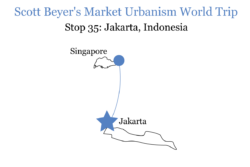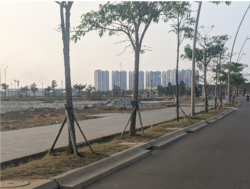Should Global South Megacities Be Decentralized?
Planners in Indonesia and other Third World countries are making sprawling, autocentric plans to supplant their dense cities—repeating America’s past mistakes.
Jakarta is among the densest cities on earth, rivaling other megacities like Tokyo and Hong Kong. The region is set to further grow, even while facing an impending crisis of sinking as a city. 40% of Jakarta’s population lives below sea level, there is frequent flooding and unsanitary water, along with traffic and crime. Government leaders are thus shifting the capital to a different island, invoking a decentralization strategy that I’m finding across the Third World, as developing countries wish to disperse their population like the U.S. once did.
In 2019, Indonesia’s government announced a plan to relocate the capital to a new city, Nusantara. The city, to be built in a remote area of a different island, will accommodate 10 million residents, and planners believe it will prove more sustainable than Jakarta. Indonesia has developed new population centers for some time, called “new towns.” In many cases, these resemble America’s postwar development patterns, decreasing residential and employment density and pushing people further from the core.
Jakarta has experienced immense growth, as have other Indonesian cities. According to National Geographic, they’re slated to grow 75% by 2030, and account for around 60% of GDP. But the wrinkle is that this growth often happens in the outlying parts of major cities.

Wendell Cox observes that Jakarta suburbs outpaced growth in the city beginning in the 1970s. While the city retained its high density (housing 20% of Indonesians on 12% of the country’s land area), Cox wrote, “the overall density of the Jakarta urban area has declined as population has moved to the outer suburbs…The inner suburbs have a population density that is only two thirds that of the city of Jakarta.”
Previously agricultural land was redeveloped into subdivisions (causing displacement of farmers), with over 30 new communities built from 1990 to 2010. I observed several such projects, including PIK 2, a bayside land reclamation effort that is being promoted by real estate as a new city north of Jakarta.

Indonesia has complemented this new suburbia by building an extensive network of highways. Between 1990 and 2020, 93 miles of highway were built, along with many commuter rail lines. It’s a centrally-planned pro-sprawl paradigm straight from the playbook of post-WWII America. We built an interstate highway system, demolished urban “slums” with eminent domain, and subsidized single-family homes to be built in large master-planned communities on the urban outskirts.
Indonesia, along with its capital relocation, is doing all these things as well. And so are many other cities I’m visiting on my 1.5-year trip through the Global South. The “startup cities” I’ve profiled in this series tell part of the story. In Lagos, dozens of new communities are being built with government support along the Lekki area, to lure people off of the city’s crowded mainland. Brazil is teeming with these projects also, as part of a longstanding initiative to decentralize—in fact, the capital, Brasilia, was built in part to improve the fortune’s of the country’s interior.
Indonesians can’t be blamed for gravitating to this development. Jakarta is chaotic and overcrowded, like other Third World cities. It has dirty tap water, open sewage canals, exposed electrical lines, and other infrastructure failures, while these new cities build infrastructure from scratch to a First World standard. And new cities, particularly ones with some sort of special jurisdiction status, are a chance to test different models of governing.
Extreme monocentricity also has costs. As I’ve noted before, Global South megacities have some of the world’s worst congestion, owing in large part to their dominant central business districts. It’s a hub-and-spoke layout that encourages everyone to go in the same direction at the same time. Jakarta’s no exception, with the world’s 22nd worst congestion.
But Jakarta, like U.S. cities that deal with congestion, has sprawled for decades now, and congestion has only grown worse, likely because people still must access the city core. Despite Jakarta’s intense density, urban planning academic Daniel Caesar Pratama writes that it has height limits covering broad swaths of the city.
“Roughly 40% of Jakarta is zoned as residential areas dominated by small single-family houses and kampungs,” Pratama says.
So it seems that much of what ails Jakarta, at least traffic-wise, is that the market hasn’t been allowed to work, instead favoring sprawl over density. In this way, too, it mirrors U.S. cities, with their strict regulations on high-rise density in particular.
Beyond that, the biggest problem with decentralization is that it ignores the economic conditions impelling people into Jakarta. Cities are agglomeration economies—“labor markets”, in the words of NYU professor Alain Bertaud—that people gravitate to for jobs and lifestyle. While in Jakarta, I asked various locals if they’d rather live in the current capital or this new one in Nusantara. They all answered the former. Inherent in their answer is a certain economic logic that recognizes the benefit of clustering.
Of course, if there is market demand for decentralization, by all means allow it. Nations like Indonesia are full of a growing middle class that wants to enjoy the same suburban dream they see in the U.S. But if that’s the case, there’s no need to subsidize the process, much less move the whole capital. Ultimately, that just means subsidizing a development pattern that’s inefficient, and may well lead to more congestion.
Graphic Credit: The Market Urbanist.
Catalyst articles by Scott Beyer | Full Biography and Publications
